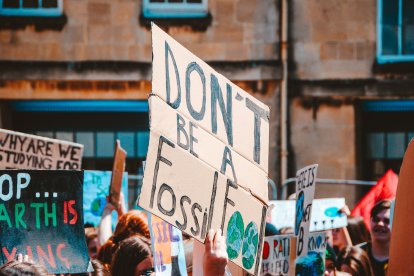The business of the "climate aristocracy"
Energy journalist Robert Bryce analyzed the risks that the growth of the climate aristocracy present to U.S. prosperity.

(Unsplash)
The business of NGOs fighting against climate change and for a world powered by green energy continues to boom. Research shows that, in 2021, the 25 best-known organizations received more than $4.5 billion to promote green policies and sustainable energy. The main objective appears to be shutting down the hydrocarbon fuel sector. The cost that the initiatives of this "climate aristocracy" to the middle and lower class has been brutal, especially due to taxes on "polluting energies." The growth of this "anti-industry industry" poses significant risks to the long-term prosperity of the country.
In an article published on Substack, energy journalist Robert Bryce reported that the revenues of these organizations have nearly tripled since 2017, when these organizations raised about $1.8 billion. By 2021, that amount had risen to $4.503 billion. Among the main benefactors are the Rockefeller Brothers Fund, the Chan Zuckerberg Initiative and the Bezos Earth Fund. All are linked to some of the world's richest men, "a class of people with a lot of money who have no connection to the real economy. The price of gasoline and electricity doesn't matter to them," according to researcher and author Joel Kotkin.
Success of the climate aristocracy
These NGOs use this money "to fund campaigns on climate change, as well as efforts to promote renewable energy, stop the production of hydrocarbons, halt construction of new hydrocarbon infrastructure, prohibit the use of natural gas, oppose nuclear energy, and electrify everything," according to Bryce. Implementing these measures in the real economy would lead to higher costs and higher taxes. The intention to make electricity the main source of energy deserves separate mention, as this "would require massive increases in electricity production and the size of the power grid."
None of this seems to worry anti-industry advocates, including many politicians. Bryce recognizes that the work of these organizations has been very effective:
A vicious cycle
One explanation for this success, in addition to the money invested in their campaigns, lies in the feedback between activists, academia, the media and politicians, who have established a vicious cycle, as Bryce puts it:
The rhetoric of fear
Another of their strengths is the rhetoric of fear used by these groups to embellish their arguments. "The climate clerisy continually sells fear: fear of catastrophic climate change, fear of radiation, and fear of fracking." This technique allows them to achieve their objectives without taking into account the consequences of their actions. This is the case of the success achieved by the Natural Resources Defense Council (NRDC), whose pressure was critical in bringing about the premature closure of the Indian Point nuclear power plant in New York. The closure immediately caused a sharp increase in New Yorkers' electric bills and, paradoxically for climate aristocracy, a considerable increase in the state's greenhouse gas emissions.
Moreover, one cannot disagree with this rhetoric without being singled out. This is what leads Bryce, quoting Kotkin, to call them "the clerisy." Kotkin analyzes: "Climate change is to neo-feudalism what Catholic dogma was in the Middle Ages. It’s a justification for autocracy. The climate agenda plays the same roles today as Catholic dogma did back then. There are things you can’t say because it questions the dogma."
Attack on rural areas
However, their concern for the environment takes a back seat when it clashes with the interests of the climate aristocracy. For example, these organizations ignore the impact of the expansion of renewable energies on the rural and agricultural world, which destroys large areas to install windmills or solar panels despite complaints from farmers and ranchers. Nor do they mind spreading hoaxes accusing their detractors of being "facades" that spread disinformation on behalf of companies in the hydrocarbon sector. Bryce gives several examples:
No tangible products
Another disadvantage of the traditional energy sector is that they have to deliver something tangible to their customers: gasoline, natural gas, electricity, etc. In addition to generating it, they must pay for its transportation to consumers. However, "The climate aristocrats don’t have to deliver anything of tangible value (tankers of diesel fuel, decatherms of gas, or kilowatt-hours) in the physical world. That helps explain why the traditional energy sector is getting its collective butt kicked in the policy arena". In other words, "it’s a lot easier to convince the Berkeley City Council to adopt a ban on natural gas than it is to deliver that fuel and do so reliably and affordably to thousands (or millions) of homes and businesses."
RECOMMENDATION





















